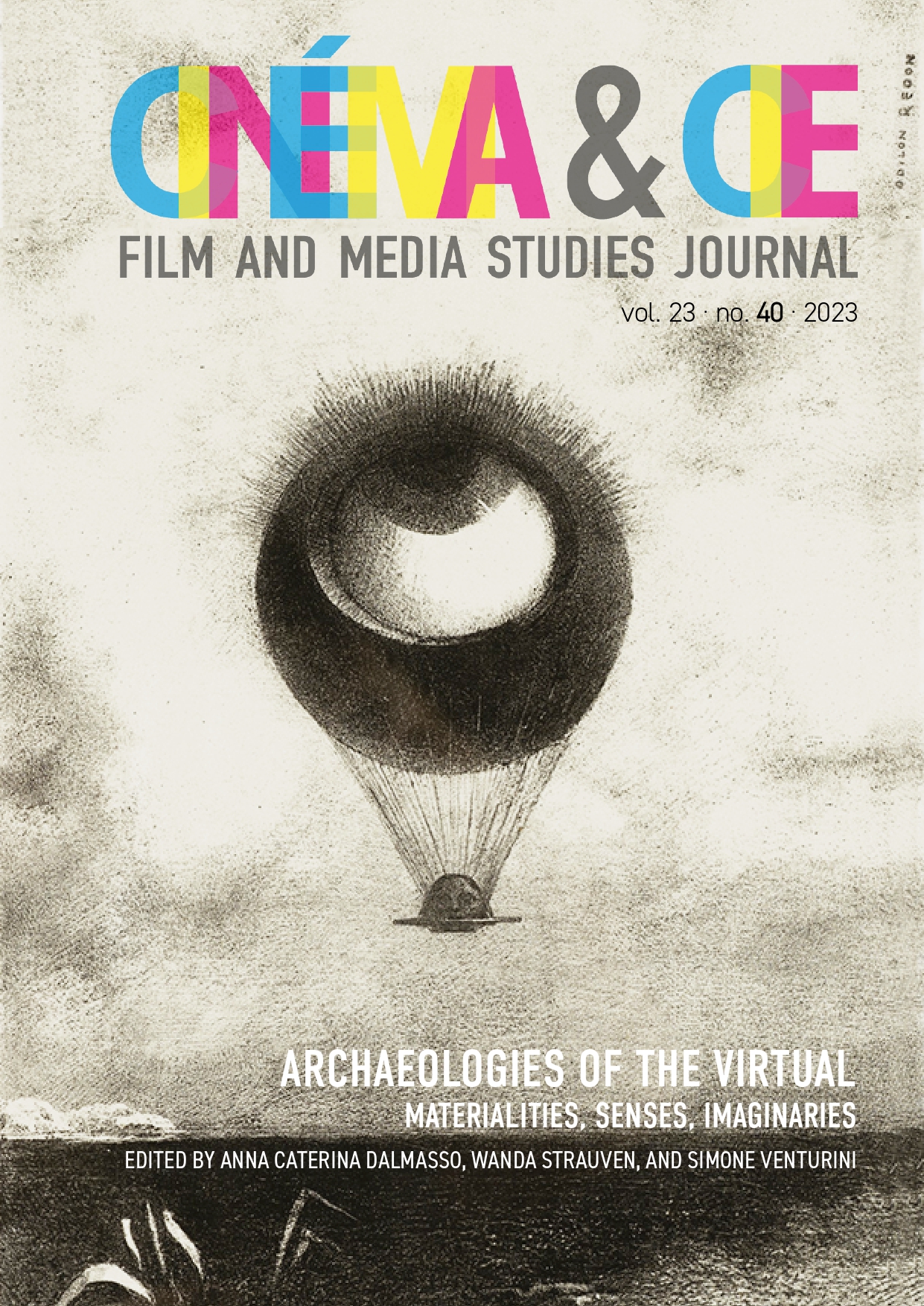Pour une archéologie cinématographique de la condition immersive: La Jetée (Chris Marker, 1962)
DOI:
https://doi.org/10.54103/2036-461X/19396Keywords:
Immersive Condition, Museum, Chris Marker, La JetéeAbstract
Today we tend to emphasise the technological dimension of immersive devices, insisting on the notions of interactivity, virtual reality or augmented perception— all of which promise to intensify museum experience or the film experience. But it must be recognised that the principle of immersion is older than the more or less recent definitions of immersive devices or museography. Certain primordial forms of scenarisation, of staging and of dramatisation were able to play an immersive role very early on, foreshadowing the installation of the subject of perception in an attitude of adhesion, which can go as far as subjugation. Scripting, staging, psychic projection: if an archaeology of immersion is required, it must include an account of the role of cinema in the formation of the immersive condition. Our hypothesis is that an archaeology of immersion must pass through cinema: not only through its device, but primarily through its fictions, narratives, and figurations. In this perspective, we propose to examine the historical contribution of cinema to the formation of the immersive condition, through an analysis of Chris Marker’s La Jetée (1962). If this unique film has often been studied, its capacity to stage different fundamental aspects of an immersive experience, involving at the same time the interplay of memory, aesthetic relation, and the psyche, has not been considered yet.
References
Barthes, Roland. 1975. “En sortant du cinéma.” Communications 23: 104–107.
Belaën, Florence. 2005. “L’immersion dans les musées de science: médiation ou séduction.” Culture & Musées 5: 91–110. doi:10.3406/pumus.2005.1215.
Courvoiser, François H., and Antonia Jaquet. 2010. “L’interactivité et l’immersion des visiteurs. Nouvel instrument de marketing culturel.” Décisions Marketing 60: 67–71.
Damm, Paul. 2017. Orly, aéroport des sixties. Lyon: Editions Lieux-Dits.
Dubois, Philippe. 2002. “La Jetée de Chris Marker ou le cinématogramme de la conscience.” Théorème 6: 9–44.
Foucault, Michel. 1969. L’Archéologie du savoir. Paris: Gallimard.
Freud, Sigmund. 1987. Un souvenir d’enfance de Léonard de Vinci. Paris: Gallimard.
Goliot-Lété, Anne, Martine Joly, Thierry Lancien, Isabelle-Cécile Le Mée, and Francis Vanoye. 2006. Dictionnaire de l’image. Paris: Vuibert.
Grau, Oliver. 2003. Virtual Art. From Illusion to Immersion. Cambridge MA: MIT Press.
Husserl, Edmund. 2001 [1929]. Méditations cartésiennes. Introduction à la phénoménologie. Paris: Vrin.
Kuntzel, Thierry. 1993. “Notes sur La Jetée.” In Thierry Kuntzel, 32–37. Paris: Galerie nationale du Jeu de Paume (catalogue d’exposition).
Laborde, Barbara. 2009. “Avatars de l’Histoire, Warburg et Marker.” Image & Narrative 10(3): 47–58.
Lacoste, Anne, Nathalie Boulouch, Olivier Lugon, and Carole Sandrin. 2017. Diapositive. Histoire de la photographie projetée. Lausanne: Musée de l’Elysée (catalogue d’exposition).
Le Maître, Barbara. 2019. “Fiction de dispositif. Notre ethnographie: La Jetée (Chris Marker, 1962) et le diorama.” In Exposing the Moving Image. The Cinematic Medium Across World Fairs, Art Museums, and Cultural Exhibitions, edited by Diego Cavallotti, Simone Dotto, and Andrea Mariani, 191–197. Milan-Udine: Mimesis.
Malraux, André. 1974. La Tête d’obsidienne. Paris: Gallimard.
Marin, Louis. 1994. De la représentation. Paris: Seuil.
Marker, Chris. 1952. “Lettre de Hollywood. Sur trois dimensions et une quatrième.” Les Cahiers du cinéma 25: 26–34.
Marker, Chris. 1992. La Jetée ciné-roman. New York: Zone Books.
Marker, Chris. 2003a. “C’était un drôle d’objet.” Livret DVD de La Jetée – Sans Soleil.
Marker, Chris. 2003b. “De l’autre côté du miroir.” Livret DVD de La Jetée – Sans Soleil.
Metz, Christian. 1993 [1977]. Le Signifiant imaginaire. Paris: Christian Bourgois.
Panofsky, Erwin. 1975 [1924]. La Perspective comme forme symbolique. Paris: Minuit.
Pinotti, Andrea. 2020. “Towards an-iconology: the image as environment.” Screen 61(4): 594–603. doi:10.1093/screen/hjaa060.
Proust, Marcel. 1913 [1989]. À la recherche du temps perdu. Paris: Gallimard, La Pléiade.
Terrin, Jean-Jacques. 2008. Le Monde souterrain. Paris: Hazan.
Schefer, Jean Louis. 1980. L’homme ordinaire du cinéma. Paris: Cahiers du Cinéma, Gallimard.
Schnapp, Alain. 2020 [1993]. La Conquête du passé. Aux origines de l’archéologie. Paris: La Découverte/Dominique Carré.
Strauven, Wanda. 2013. “Media Archæology: Where Film History, Media Art and New Media (Can) Meet.” In Preserving and Exhibiting Media Art. Challenges and Perspectives, edited by Julia Noordegraaf, Cosetta Saba, Barbara Le Maître, and Vinzenz Hediger, 59–99. Amsterdam: Amsterdam University Press.
Wollen, Peter. 1984. “Feu et glace.” Photographies 4: 16–21.
Downloads
Published
How to Cite
Issue
Section
License
Copyright (c) 2023 Barbara Le Maître, Natacha Pernac, Jennifer Verraes

This work is licensed under a Creative Commons Attribution 4.0 International License.





